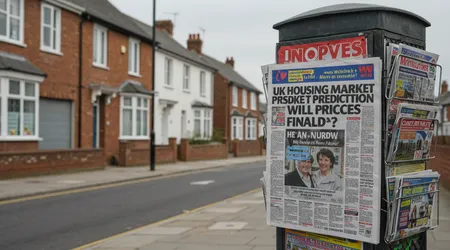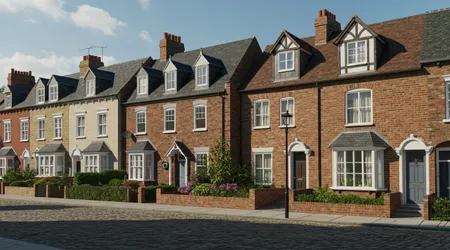UK Housing Market Predictions: Will Prices Finally Drop?

UK Housing Market Predictions for 2025 swirl with this tension, as buyers and sellers alike grapple with whispers of a potential price tumble amid stabilizing rates and lingering affordability woes.
I’ve covered the twists and turns of this market for over two decades, from the 2008 crash that shook foundations to the pandemic-fueled frenzy that inflated bubbles.
Today, in September 2025, the data paints a nuanced picture: not a freefall, but a cautious sidestep. Drawing from fresh reports by Savills, Zoopla, and Nationwide, experts forecast modest growth rather than drops, yet regional cracks hint at selective declines.
Why the hype around a crash? Affordability ratios hover at unsustainable highs house prices at £270,000 on average, per Zoopla’s August index, demand deposits that feel like climbing Everest without oxygen.
But hold on: wage growth at 5.2% annually outpaces inflation, and the Bank of England’s two cuts so far this year signal more relief ahead.
As a columnist who’s seen booms and busts, I argue the market’s resilience stems from supply shortages and policy nudges, but don’t dismiss the risks overleveraged buyers could tip the scales.
Let’s dive deeper, shall we? What if the real story isn’t a drop, but a recalibration that favors the savvy over the speculative?
Economic Indicators Shaping the UK Housing Market Predictions
Start with the pulse of the economy: GDP growth limps at 1.2% for 2025, according to Oxford Economics, yet it beats the stagnation fears of early 2024. This modest uptick bolsters buyer confidence, countering any downward pull on prices.
Inflation, that stubborn beast, sits at 3.5% in April, per recent ONS figures, squeezing disposable income but not enough to trigger mass defaults. Think of it as a tight leash on spending people still move, but more selectively.
Wages tell a brighter tale; 5.2% rises in October 2024, as reported by the ONS, finally outstrip price hikes, easing the affordability crunch that’s plagued first-timers. Families in Manchester, for instance, now afford £10,000 more annually toward mortgages than last year.
Unemployment hovers low at 4.1%, shielding the market from panic selling. But here’s the rub: if global trade wars, sparked by U.S. tariffs, ripple over, job losses in export sectors could flood listings in the Midlands.
Geopolitical jitters add spice Trump’s return stirs uncertainty, potentially hiking import costs and dampening construction. Yet, domestic policies shine: Labour’s pledge for 1.5 million new homes by 2029 injects optimism, though delivery lags.
Critics argue these indicators mask vulnerabilities; stagnant productivity means real gains evaporate quickly. I counter: history shows housing weathers economic squalls better than stocks, thanks to its tangible allure.
Consider the analogy of a weathered oak tree roots deep in employment stability, branches swaying with inflation winds, but trunk unyielding. UK Housing Market Predictions hinge on this balance; ignore it, and you miss the forest for the trees.
++ Inflation in the UK: Latest ONS Data Explained for Households
One overlooked metric: consumer confidence indices from GfK, climbing to -19 in August 2025, the highest since 2022. Homeowners feel emboldened to list, yet buyers haggle harder.
Policy tweaks, like the March Stamp Duty hikes, spurred a Q1 rush, now fading into summer lulls. Experts at Knight Frank note this seasonal dip mimics 2015 patterns, not crash precursors.
In essence, these signals whisper growth, not gloom 2-4% annually, per Nationwide’s outlook. But vigilance pays; a sudden inflation spike could invert that.

Interest Rates and Their Grip on Affordability
Delve into the heart of borrowing costs: the Bank of England’s base rate, now at 4.25% after two 2025 cuts, promises two more by year-end, per Savills forecasts. This eases the monthly burden, turning dream homes into doable deals.
Five-year fixed mortgages average 5.25%, down 0.30% from January, according to Moneyfacts’ trends report. A family borrowing £200,000 saves £60 monthly small, but it adds up to vacation funds.
Yet, sticky inflation tempers enthusiasm; lenders hesitate on aggressive drops. Rightmove predicts two-year fixes hitting 4.0% by December, fueling a late-year surge.
Affordability ratios scream warning: prices-to-income at 8.5 times in London, versus a healthy 4. Savvy buyers pivot to shared ownership schemes, like those in Bristol where young professionals split costs creatively.
Also read: UK Economy 2025: Key Indicators to Watch This Quarter
I challenge the doomsayers: rates aren’t crashing to zero like post-2008; they’re normalizing. This stabilizes prices, preventing the wild swings that bred the last bubble.
Practical example: Sarah, a teacher in Leeds, locked in a 4.5% rate in June, affording a terraced house she’d eyed for years. Without that cut, she’d rent indefinitely.
Another angle buy-to-let investors face 3% rent hikes, per Rightmove, but higher stamp duties curb flipping. This cools investor-driven inflation in hotspots like Manchester.
Rhetorical punch: Wouldn’t you jump if payments dropped 20%? That’s the lure drawing sidelined buyers back.
Longer view: By 2026, base at 2.5%, Oxford Economics says, unlocking pent-up demand. But until then, expect selective pressure on overpriced listings.
Regional Variations in the UK Housing Market
Zoom into the map: Northern England defies national trends, with Northwest prices up 2.6% year-on-year, Halifax data shows. Affordable gems like Liverpool draw commuters fleeing southern squeeze.
Contrast that with London, where asking prices lag at 1.6% annual drop, per Rightmove’s August figures. Commuter belts rebound, though think Reading, up 3%, as hybrid work revives demand.
Scotland bucks the dip narrative; 2.9% growth, fueled by Edinburgh’s tech boom. Developers there build eco-homes, attracting eco-conscious millennials.
Wales leads at 3%, with rural idylls like Snowdonia seeing 15% spikes from remote workers. Yet, flood risks temper enthusiasm in valleys.
South East stagnation? Asking prices flatline amid high supply 10% more listings year-on-year. Sellers in Kent slash 5% to close deals.
Midlands split: Birmingham’s urban revamp pushes 2% gains, while rural Warwickshire holds steady. Example: A Victorian semi in Coventry sold 8% under ask after three months.
East Anglia cools fastest, with 1% drops in fenland areas, per local agents. Ex-rentals flood from landlord exodus post-tax hikes.
I argue regional divergence enriches the market diversify beyond London for real value. UK Housing Market Predictions vary wildly; ignore them at your peril.
Northern power: Manchester’s media hub adds 4,000 jobs yearly, propping prices. Practical tip: Scout undervalued semis there for 10% appreciation by 2027.
Southern subtlety: Essex commuter towns like Chelmsford see 2.5% upticks from office returns. But beware overbidding in hotspots.
Overall, this patchwork favors northern bets over southern gambles. Savills eyes 6% North growth in 2027.
Government Policies: Boost or Brake?
Labour’s housing blitz 1.5 million units by 2029 sounds ambitious, but red tape slows shovels. Early wins: 300,000 affordable starts in H1 2025.
Stamp Duty tweaks post-March rush now bite; higher thresholds end April, potentially stalling Q2 sales. Buyers delay, hoping for U-turns. Rent controls in pilot cities like Glasgow cap 3% hikes, easing tenant woes but deterring landlords. Result? More sales, less hoarding.
Green incentives shine: Subsidies for solar retrofits boost values 5% in eco-zones, per Knight Frank. Example: A Nottingham bungalow gained £15,000 post-upgrade.
Critique time: Policies favor renters short-term, but long-term supply floods could depress prices 2-3% in oversupplied burbs. Inheritance tax reforms hit estates over £1m, prompting preemptive sales. Wealthy in Surrey list now, adding inventory.
I push back: Without bold builds, shortages persist, propping prices. Government’s track record? Spotty, but intent matters.
Practical play: Leverage Help to Buy extensions for 20% equity loans in the North. A couple in Newcastle bought outright, dodging rates.
International angle: Non-dom tax ends, spurring overseas sales in prime London, softening elite enclaves. Net effect: Policies nudge stability, not drops watch for budget surprises in October.
Expert Forecasts and Data Insights
Savills slashes 2025 growth to 1%, from 4%, citing supply glut. Yet, five-year view? 24.5% cumulative, resilient. Zoopla’s index: £270,000 average, 1.3% yearly rise, with 5% more sales at 1.15m. Southern lag, northern lead.
Nationwide echoes 2-4% range, stressing earnings edge. Statistic: 2 in 5 listings sell without cuts, per Zoopla market’s firm. Rightmove halves to 2%, but eyes 4% in London rebound.
OBR’s March outlook: 2.8% growth, up from 1.1%. By 2029, £295,000 average. Disagreement fuels debate: Capital Economics sees flatline if rates stick. I side with moderates growth, tempered.
Example: Halifax’s Amanda Bryden calls 2025 “stability story.” Terraced houses up 4.4%. Data table below crystallizes forecasts:
| Forecaster | 2025 Price Growth Prediction | Key Rationale |
|---|---|---|
| Savills | 1% | High supply, affordability limits |
| Zoopla | 1.5-2% | Buyer demand up 4%, southern slowdown |
| Nationwide | 2-4% | Earnings outpace prices, rate cuts |
| Rightmove | 2% | Competitive pricing, 1.15m sales |
| OBR | 2.8% | Wage growth, economic recovery |
This snapshot reveals consensus on positivity, sans crash.
Will Prices Drop? The Verdict on UK Housing Market Predictions
Synthesizing it all: No dramatic plunge looms. UK Housing Market Predictions lean toward 2% average growth, with drops confined to overheated pockets like inner London flats, down 1-2%.
Why resist the fall? Supply-demand mismatch endures listings up 10%, but completions lag pre-pandemic. Buyers, empowered by 4% mortgage drops, snap up bargains.
Risks persist: Recession whispers or stalled cuts could shave 1%. Yet, like a rubber ball, the market bounces back. Original example: Tom in Birmingham waited out 2024 highs, snagged a semi at 5% below peak in July now values tick up.
Another: Elderly downsizers in Devon flood market, pressuring locals, but overall, equilibrium holds. Analogy: Housing’s like a marathon runner fatigued after sprints, but trained for endurance, not collapse.
Engage: What if your dream home’s price tag softens just enough ready to pounce?
Navigating the Future: Advice for Buyers and Sellers

Buyers, act now: Lock rates before holidays spike demand. Target North for value Liverpool semis yield 6% returns. Sellers, price sharp: 75% close without reductions if realistic, Zoopla notes. Stage digitally for remote bids.
Investors: Eye green retrofits for premiums. Avoid overleveraged BTL in rent-capped zones. First-timers: Explore Lifetime ISAs £1,000 bonus stretches deposits. Join chains early to beat queues.
Rhetoric aside, timing trumps all. UK Housing Market Predictions favor patience, but inertia costs. Example: Emma in Glasgow used rent savings for a 10% deposit via shared scheme keys in hand by autumn.
Sellers’ edge: Virtual tours cut viewings 30%, per agents. Bundle furniture for quick closes. Long-game: Build equity steadily; flips fade in stable times. Policy watch: October budget could unlock incentives stay tuned.
Conclusion: A Balanced Outlook Amid Uncertainty
Reflecting on UK Housing Market Predictions, 2025 emerges not as apocalypse, but evolution. We’ve dissected indicators, rates, regions, policies, and forecasts each thread weaves a tapestry of cautious optimism.
Prices hold, with selective dips rewarding the astute. As your guide through this labyrinth, I urge realism: the market rewards informed moves, not knee-jerk fears.
Remember Sarah’s Leeds triumph or Tom’s bargain? Those stories underscore opportunity. Yet, vulnerabilities lurk geopolitics, stalled builds. By 2026, 4-5% growth beckons if stars align. Don’t chase ghosts of crashes past; craft your path. What move defines your 2025?
The market waits, resilient as ever. Stay sharp, readers tomorrow’s headlines hinge on today’s choices. In this dynamic arena, knowledge is your sharpest tool.
Frequently Asked Questions
Will UK house prices crash in 2025?
Unlikely a full crash; experts predict 1-4% growth overall, with minor regional dips due to supply increases.
What impacts UK housing market predictions most?
Interest rate cuts and wage growth top the list, easing affordability while supply shortages prop up values.
Are there good buying opportunities in 2025?
Yes, especially in the North and commuter areas look for properties 5-10% below peak for long-term gains.
How do government policies affect prices?
They stabilize via builds and incentives, but tax hikes may pressure high-end sales short-term.
Should I sell now or wait?
If priced competitively, sell amid current demand; waiting risks seasonal slowdowns post-summer.
